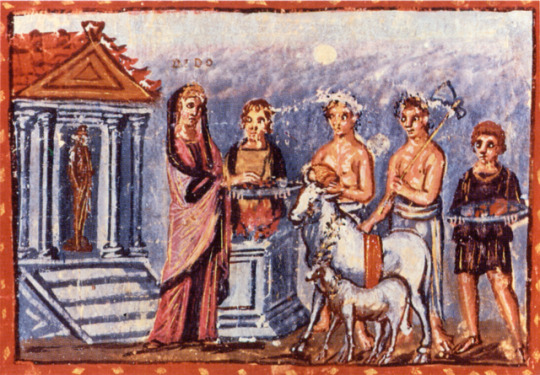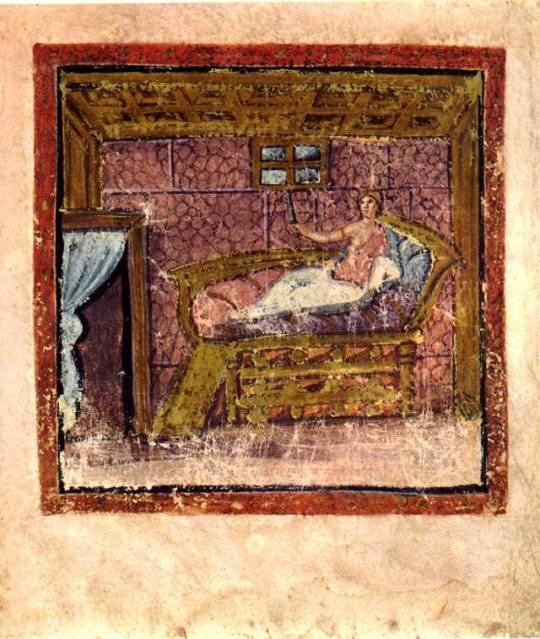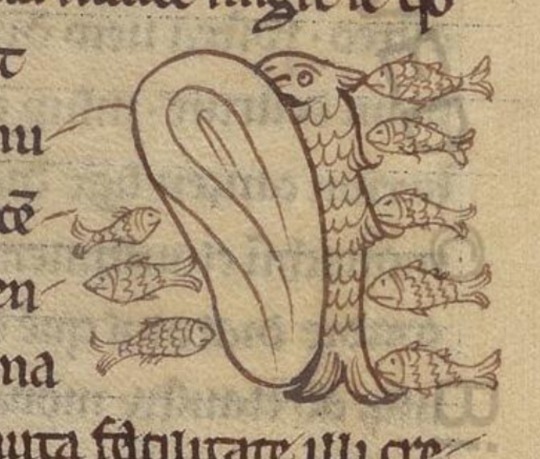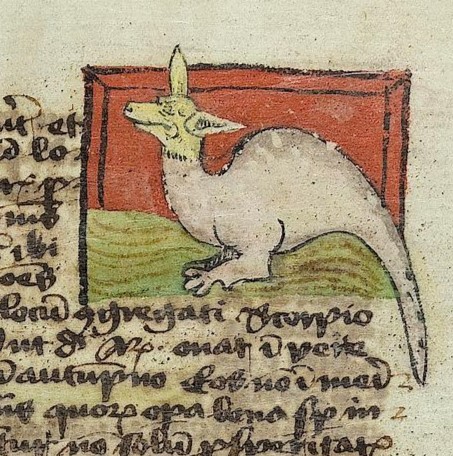#Biblioteca Vaticana
Text




Ansichtskarte / Vintage Postcard
Biblioteca Vaticana
Laboratorio Fotografico
Terni: Alterocca (47520)
#Philokartie#Vatikan#akVatikan#Bibliothek#Bibliotheksalltag#Bibliophilokartie#Fotografiegeschichte#Reproduktionsfotografie#Makerspace#Buchkultur#LibraryLife#Libraries#Bibliothekstechnik#Fototechnik#Biblioteca Vaticana#Alterocca
7 notes
·
View notes
Text

giant ant attacking a young man
in thomas de cantiprato's "liber de natura rerum", bavaria, c. 1424
source: Vatican, Biblioteca Apostolica Vaticana, Pal. lat. 1066, fol. 140v
#15th century#medieval art#ants#giant ant#bestiary#medieval bestiary#thomas de cantiprato#liber de natura rerum
411 notes
·
View notes
Photo



Vergil's Aeneid from the Vergilius Vaticanus illuminated manuscript kept in the collection of the Biblioteca apostolica Vaticana. MS lat. 3225. fol. 33 v; by the Master of the Vergilius Vaticanus; 5th century AD
#5th century#mdpearly#mdpancient#manuscript#illuminated manuscript#5th c. rome#rome#ancient rome#ancient manuscript
102 notes
·
View notes
Text
hey have you guys ever looked up depictions of octopodes in medieval bestiaries because




what’s going on here
(shelfmarks in order from top left: Koninklijke Bibliotheek, KB, KA 16 (Der Naturen Bloeme), folio 108v; Biblioteca Apostolica Vaticana, Reg.lat.258, folio 25v; British Library, Additional MS 11390 (Der Naturen Bloeme), folio 60r; British Library, Additional MS 11390 (Der Naturen Bloeme), folio 54r)
#everyone knows an octopus is just a fish with a strange configuration of arms/legs/human arms/wings!#and of course whatever is going on with that second one
90 notes
·
View notes
Note

scorpion in thomas of cantimpré's 'liber de natura rerum', bavaria, c. 1424. Vatican, Biblioteca Apostolica Vaticana, Pal. lat. 1066, fol. 132v
[Image ID: A bipedal creature with a grayish body and a tail. It kind of looks like a chicken in silhouette, but with tail and feet like a lizard. Its head is yellow rather than gray, and looks vaguely canine. At least if you had a dog who was bald, wrinkly, yellow, 100 years old, and in a bad mood about it.]
This is so extremely not a scorpion. If there hadn't been a couple of critters with this body plan in the original post, I would be completely floored by this one's existence. Even so, I'm still just kind of staring at it in confusion.
Like, let's be clear here, this is not what Mr. Of Cantimpre is describing in the text. He includes such items as:
A scorpion is a serpent, as Solinus says, which is said to have a charming and virgin-like face.
But it certainly has a poisonous sting in its knotted tail, with which it stings and infects any that approach it.
The scorpion is the only insect that has a tail, and arms, and a spike in the tail.
(I found a translation this time instead of fighting with the Latin -- this is from https://bestiary.ca/ . They admit that this is a machine translation with a human editor, so grain of salt, though.)
None of this is represented in the illustration. Like, Tommy Boy up there can't seem to decide whether this is a serpent or an insect (I'm going to assume the overly-flexible term worm is at fault in this case), but the animal pictured seems to be neither. Its tail is neither knotted nor spiked. You could maybe argue that those are arms. Not on board with the illustrator's interpretation of "charming and virgin-like face"... okay, I guess it's kind of ugly-cute, but that's a stretch.
Anyhow, points:
Small Scuttling Beaſtie? scale unclear, not enough legs, ✘
Pincers? ✘
Exoskeleton or Shell? ✘
Visible Stinger? ✘
Limbs? 2
Vibes... eh. It has charming aspects, but it has this bad-tempered expression on a face that I'm not sure how to react to. 3/5.
Total:
3.2 / 10
I have questions about the illustrator's tastes.
68 notes
·
View notes
Photo

The earliest depiction of people wearing costumes on Purim, from Sefer Zemanim (the Book of Holidays), in Maimonides’ Mishneh Torah. Original in Vatican City, Biblioteca Apostolica Vaticana. From northern Italy, ca. 1470. Image courtesy of Shalom Sabar.
Reminder that the Catholic Church looted, pillaged, rounded up, murdered, and committed atrocities against Jews while stealing our sacred and precious texts, including our art; much of which has not been returned.
306 notes
·
View notes
Text

I'm a special collections/manuscript librarian in my day job, and the main collection I work with features microfilm reproductions of about half of the manuscript libraries in the Biblioteca Apostolica Vaticana. And it turns out (I didn't actually know this until I started reading Anthony Grafton's Magus) that those collections include a very important Faustian document: the correspondence of one Abbot Johannes Trithemius, another scholarly magician who in the letter shown above had just heard about a certain fellow calling himself Georg Sabellicus or Faustus junior, who was traveling around making extravagant claims (Trithemius is quoting his business card), doing horoscopes, and persuading nobles to use arsenic as hair remover. Trithemius considered himself a real magician, of course, and here he is basically complaining that Faustus Georg is giving the profession a bad name.
Grafton's chapter on Trithemius suggests that he was a pretty weird guy himself, and that his own portrayal of his abilities was pretty similar to what Faustus Georg was claiming, so no wonder he kinda took it personally. One of the anecdotes that becomes part of the legendary Faust narrative, appearing in the Spiers Faustbuch and indeed in Marlowe's Doctor Faustus--the episode in which he summons the spirit of Alexander the Great for Emperor Charles V--actually has an analogue that's attached to Trithemius, although it's a different emperor and in that story he wants to see the ghost of his wife.
The letter above is an autograph manuscript, btw--it's in Trithemius' own hand. Very Italian-style script: it's a fairly international series of letters, although Grafton suggests that portions of it are basically just made up and were never actually sent to their purported recipients. Obviously the picture is not from our microfilm!
33 notes
·
View notes
Text

Vatikan, Biblioteca Apostolica Vaticana, Pal. lat. 1885
Alchemistische Illustrationen — Süddeutschland, um 1570-1580
#esoteric#consciousness#metaphysical#occult#masonic#rosicrucian#ancientegypt#rosecross#alchemy#magic#alchemist#art#magick#magical#spiritual
84 notes
·
View notes
Text


October 2023 | On a work trip in Rome! I had to see some documents at the Biblioteca Apostolica Vaticana, which is gorgeous but taking pictures is forbidden. And I managed to balance research (reading papers on the plane and going to the Vaticana) with sightseeing (reuniting with my sister along the way!) so... In short, work trips rule!
#my posts#studyblr#litblr#gradblr#phdblr#Roma#yes I took the plane........... 🥲#il Chiostro di Bramante is my new favourite caffè!
39 notes
·
View notes
Text
Guillaume Dufay (1397-1474)
Agnus Dei. Missa Se la face ay pale
[(36v—38) MS Capp. Sist. 14. Biblioteca Apostolica Vaticana, Vatican City, Rome ] [(104v—105v) I-TRbc MS 1375 [88] (Trent 88). Museo Provinciale d'Arte, Castello del Buonconsiglio, Trento, Italy]
Guillaume Dufay – Missa Se La Face Ay Pale
Diabolus In Musica, Antoine Guerber
(2004, Alpha Productions – Alpha 051)
22 notes
·
View notes
Text

Illustration of the Seven Sleepers of Ephesus found in the Menologium of Basil II (958-1025). Biblioteca Apostolica Vaticana, Vatican City, Manuscript - Vat.gr.1613
"As the story goes, during the rule of the Roman emperor Decius, seven young men of Ephesus were accused of being Christians. Being that a time of harsh persecution towards Christianity, they were asked to recant their faith upon pain of their life; the seven, however, decided to retire to a mountain cave where they fell asleep while praying. When they were found out, the cave was sealed and the young men trapped forever. After 200 (or 300) years, however, the sealed mouth of the cave was reopened by the landowner; to his surprise, the seven men were still there, still sleeping. As they woke up from their long slumber, they were astounded to find that so many years had passed, since they thought they had slept but one day; what surprised them the most, however, was that Christianity was now not only accepted - but it was the very official religion of the Empire. The local bishop was called to investigate and, being told their story, acknowledge the miracle. The Seven Sleepers finally died on the very same day of their awakening, once again praising God. (...)"
[Robert Scott Horton]
#Seven sleepers#Seven Sleepers of ephesus#storiers#Christian#about art#religious art#Robert Scott Horton
7 notes
·
View notes
Text



jupiter castrating saturn (and two figures growing out of saturn's severed penis)
in a copy of john ridewall's "fulgentius metaforalis", bavaria, c. 1424
source: Vatican, Biblioteca Apostolica Vaticana, Pal. lat. 1066, fol. 226r
272 notes
·
View notes
Photo

The beginning of Virgil’s Eclogues in ms. Biblioteca Apostolica Vaticana, Vaticanus Palatinus lat. 1632, fol. 3r.
27 notes
·
View notes
Text

The Lorsch Gospel. Lucerne, Facsimile Publishing House and Vatican, Biblioteca Apostolica 2000. OLdr. with ivory replicas on both lids and silver edges. 39 : 28 cm. In OLdr. cassette with mont. color. lid vignette.
1 of 333 arab. num. Copies (GA 433). - The facsimile is the faithful replica and merging of all parts of the Lorsch Gospel. The first part with the signature Ms R II I is owned by the Romanian National Library, the second part, the Codex Vaticanus Palatinus Latinus 50, is located in the Biblioteca Apostolica Vaticana. - With the commentary under the publication of H. Schefers. - 1 addition (documentation folder of the publisher).
Ketterer and Kunst
8 notes
·
View notes
Text


Menologium of Basil II (958-1025) / Menologium Basilii II, 10th century, illumination of the Seven Sleepers of Ephesus.
Biblioteca Apostolica Vaticana, Manuscript - Vat.gr.1613 https://shorturl.at/MPST3
«As the story goes, during the rule of the Roman emperor Decius, seven young men of Ephesus were accused of being Christians. Being that a time of harsh persecution towards Christianity, they were asked to recant their faith upon pain of their life; the seven, however, decided to retire to a mountain cave where they fell asleep while praying. When they were found out, the cave was sealed and the young men trapped forever. After 200 (or 300) years, however, the sealed mouth of the cave was reopened by the landowner; to his surprise, the seven men were still there, still sleeping. As they woke up from their long slumber, they were astounded to find that so many years had passed, since they thought they had slept but one day; what surprised them the most, however, was that Christianity was now not only accepted - but it was the very official religion of the Empire. The local bishop was called to investigate and, being told their story, acknowledge the miracle. The Seven Sleepers finally died on the very same day of their awakening, once again praising God. (...)»
In 'folia magazine' https://shorturl.at/jwFO8
2 notes
·
View notes
Text



Los Museos Vaticanos son las galerías y el conjunto de estancias de valor artístico propiedad de la Iglesia y accesibles al público en la Ciudad del Vaticano.
Su base fundacional fue la colección privada de Julio II, que fue elegido papa en el año 1503.
Más tarde otros papas han ido aumentando las extensas colecciones de que constan estos museos. Este conjunto museístico se compone de diferentes edificios de museos temáticos, edificios pontificios, galerías, monumentos y jardines.
A este conjunto de edificios también pertenece la Biblioteca Vaticana, una de las mejores bibliotecas del mundo. La biblioteca custodia unos 75.000 manuscritos y más de 1.100.000 libros, de los cuales 8.000 son incunables.
5 notes
·
View notes